The ancient Egyptians were famous for their way of burying their dead. Over the centuries, archaeologists have found a variety of grave goods and decorations contained in tombs dating back thousands of years.
Here are 13 objects that frequently appear in Egyptian tombs:
Copy of “The Book of the Dead”
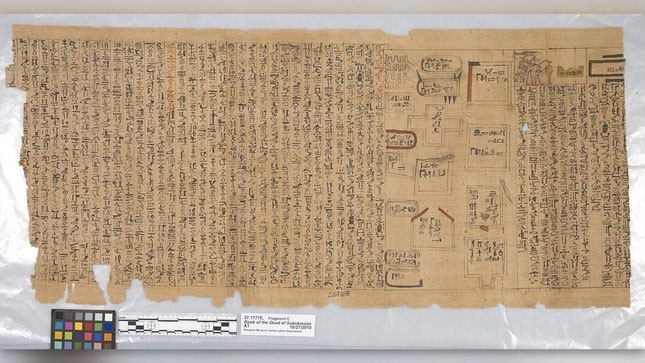 A copy of the “Book of the Dead” was found in a tomb from the 18th dynasty, around 1550 to 1295 BC. (Photo: Sepia Times/Universal Images Group).
A copy of the “Book of the Dead” was found in a tomb from the 18th dynasty, around 1550 to 1295 BC. (Photo: Sepia Times/Universal Images Group).
“The Book of the Dead” is the modern name given to a series of texts that ancient Egyptians sometimes buried with their dead. These documents were intended to help the dead reach the afterlife. The content in the various texts varied, but they often described what ancient Egyptians believed could be encountered in the afterlife, such as the heart-weighing ceremony, in which a person’s actions weighed with the feather of the goddess Maat, a deity associated with justice.
Sarcophagi – Exquisite coffins
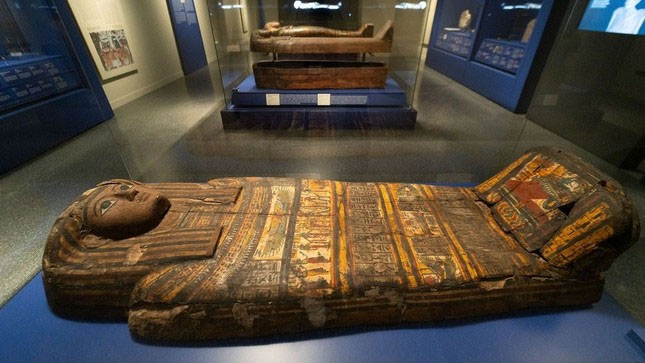 Sarcophagi are displayed at the exhibition “Egyptian Mummies” (Photo: Jorge Gil/Europa Press).
Sarcophagi are displayed at the exhibition “Egyptian Mummies” (Photo: Jorge Gil/Europa Press).
Ancient Egyptians were sometimes buried in coffins decorated with illustrations. Sometimes, elaborate coffins had hieroglyphs inscribed with the deceased’s name and prayers for them. The coffin may consist of several nested inside each other, with the mummy in the center.
Depending on the individual’s level of wealth, coffins can be made of expensive materials. For example, Tutankhamun’s coffin was made of much gold.
Portrait painting of a mummy
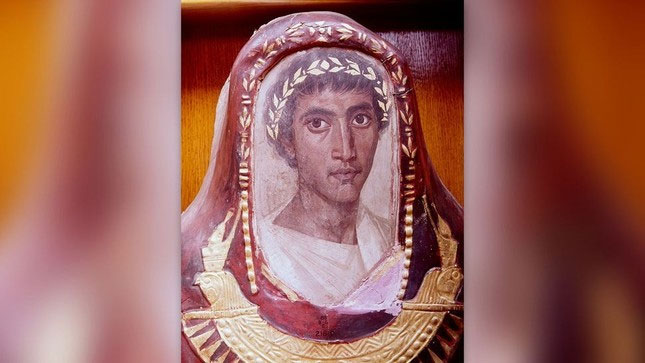 A mummy portrait of Artemidorus from Hawara, Egypt, dated to around 100 to 120 AD during the Roman period in Egypt. The golden laurel wreath on his head symbolizes that he has overcome death. (Photo: Ann Ronan Pictures).
A mummy portrait of Artemidorus from Hawara, Egypt, dated to around 100 to 120 AD during the Roman period in Egypt. The golden laurel wreath on his head symbolizes that he has overcome death. (Photo: Ann Ronan Pictures).
Susan Walker, honorary curator and keeper of antiquities at Ashmolean, England, said that mummy portraits represent vivid images of the deceased. Portraits painted on wooden panels were created from the mid-first to mid-third centuries AD, while portraits painted on shrouds continued throughout the fourth century AD. . These portraits were pasted on the mummies of the deceased.
The use of mummy portraits was especially common in the city of Fayum, Walker said, although mummy portraits have been found elsewhere in Egypt.
Shabti figurine
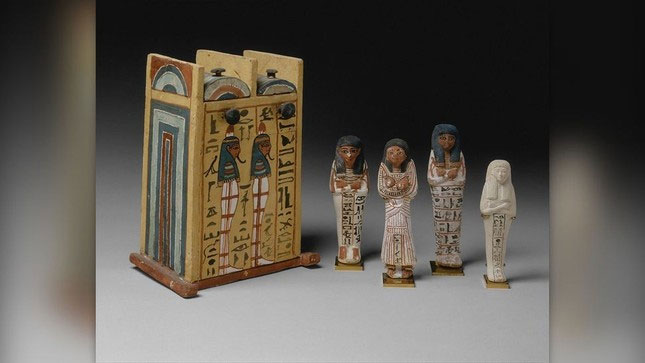 A collection of shabti figurines and a box made from painted wood, limestone and ink crafted around 1279 to 1213 BC. (Photo: Sepia Times/Universal Images Group).
A collection of shabti figurines and a box made from painted wood, limestone and ink crafted around 1279 to 1213 BC. (Photo: Sepia Times/Universal Images Group).
Shabti (also known as ushabti) figurines are used to serve the deceased in the afterlife. Depending on the grave, a person may be buried with hundreds of shabti. A simple shabti may be made of ceramic, while more elaborate shabti may be plated with gold.
Peter Lacovara, director of the Ancient Egyptian Archeology and Heritage Foundation, wrote in the book “The World of Ancient Egypt: An Encyclopedia of Everyday Life”: “Figures were often engraved a spell to magically bring them to life in the afterlife and to have both tools in hand and a basket slung over their shoulders ready to perform any task required of the deceased in the other world”.
Canopic jar
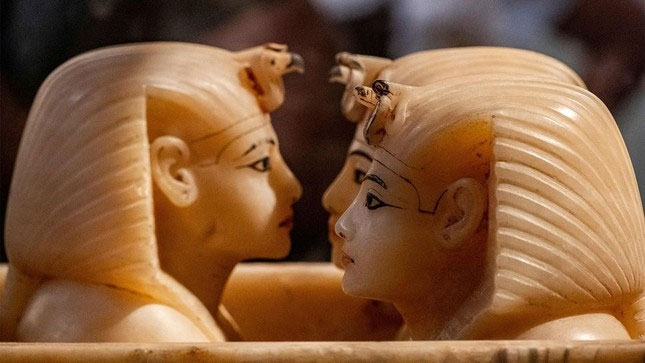 Canopic jars from King Tut’s tomb. (Photo: AMIR MAKAR/AFP).
Canopic jars from King Tut’s tomb. (Photo: AMIR MAKAR/AFP).
Canopic jars contain some of the deceased’s organs that were removed during the embalming process and buried with the mummy. According to the Metropolitan Museum of Art in New York City, organs such as the lungs, liver, intestines and stomach are all placed in separate jars.
The ancient Egyptians considered each organ of the body to be protected by one of the four sons of the falcon-headed god Horus. However, the jars were sometimes placed in a covered chest. A famous example is Tutankhamun’s tomb, which has four jars placed in a plaster chest.
Golden tongue
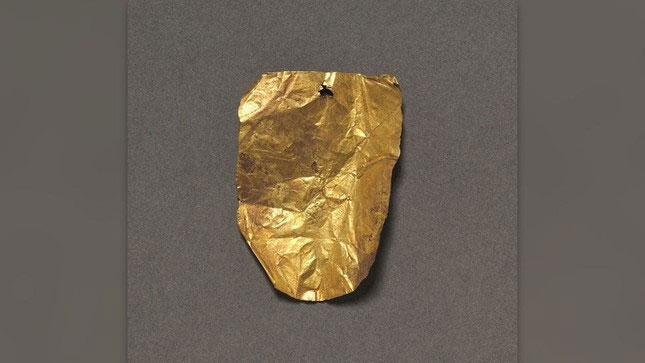 A golden tongue dating from the Roman period of Egypt. (Photo: Sepia Times/Universal Images Group).
A golden tongue dating from the Roman period of Egypt. (Photo: Sepia Times/Universal Images Group).
Golden tongues were sometimes buried with Egyptian mummies during the Greco-Roman period (332 BC to 395 AD). The Egyptians may have placed golden tongues in mummies so they could talk to the gods in the afterlife.
Mural
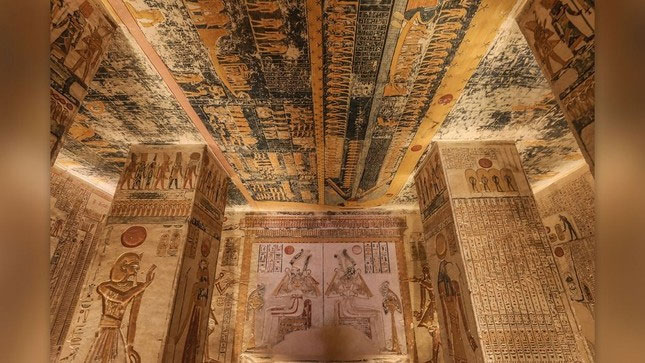 Colorful paintings inside the tomb of Ramesses VI in the Valley of the Kings in Luxor, Egypt. (Photo: Mohamed Elshahed, Anadolu Agency).
Colorful paintings inside the tomb of Ramesses VI in the Valley of the Kings in Luxor, Egypt. (Photo: Mohamed Elshahed, Anadolu Agency).
Murals sometimes decorated the tombs of wealthy ancient Egyptians. Artists painted a variety of motifs, including portraits of the deceased, images of gods, images of the deceased venerating the gods, and paintings of people mourning the deceased.
Artwork in tombs also sometimes shows images of daily life in Egypt. They can even draw images of sporting events, such as wrestling and dancing. Hieroglyphs were sometimes painted next to wall paintings and provided information about the people buried in the tombs and what they did during their lives.
Amulet
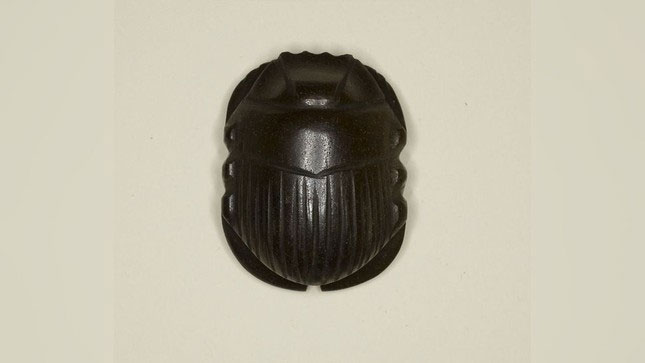 Amulets from the Ptolemaic dynasty of Egypt (305 to 30 BC) (Photo: Heritage Arts).
Amulets from the Ptolemaic dynasty of Egypt (305 to 30 BC) (Photo: Heritage Arts).
Amulets shaped like scarab beetles were sometimes buried with the deceased in ancient Egypt. Gene Kritsky, professor emeritus of biology at Mount St. “Small amulets were sewn into the mummy’s linen and used to protect the deceased,” said Joseph, who researches and writes about Egyptian amulets. Kritsky added that thousands of scarab beetles have been found in Egypt.
Place the statue in the tomb
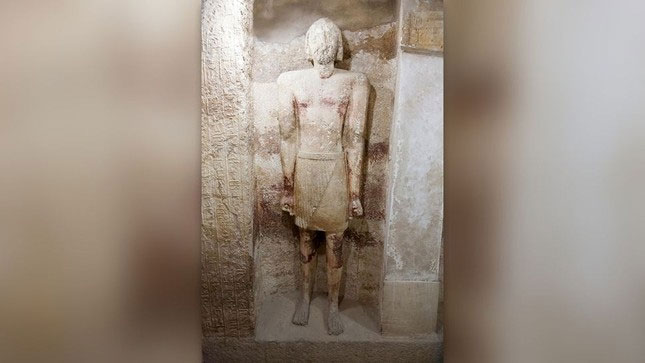 A stone carving from Fraser’s Tomb, a cliff necropolis near Al Minya, Egypt. (Photo: Mike P Shepherd / Alamy Stock Photo).
A stone carving from Fraser’s Tomb, a cliff necropolis near Al Minya, Egypt. (Photo: Mike P Shepherd / Alamy Stock Photo).
Ancient Egyptians sometimes placed statues in tombs. In some cases, these statues depict gods.
For example, in January 2024, archaeologists said they had found a statue depicting Harpocrates, a childlike Greek god associated with silence, inside a tomb with dated about 2,000 years ago at Saqqara. They may be placed to show the religious devotion of the deceased.
In April 2023, archaeologists announced that they had found a 3,300-year-old tomb in Saqqara belonging to a man named Panehsy. Inside, they found a carved relief statue of Panehsy and his family.
Jewelry
 An ancient jewelry on display at the National Museum of Egyptian Civilization. (Photo: Ziad Ahmed/NurPhoto).
An ancient jewelry on display at the National Museum of Egyptian Civilization. (Photo: Ziad Ahmed/NurPhoto).
Many pieces of jewelry – including necklaces, rings and brooches – were buried with the deceased in ancient Egypt. The richer the person, the more elaborate the jewelry.
For example, Tutankhamun’s tomb contained a large amount of jewelry, including elaborate pectorals.
Susan Allen, a senior research scholar at the Metropolitan Museum of Art, wrote in the book “Tutankhamun’s Tomb” that the design of two of the chest panels in the young king’s tomb is very unique. complex and includes depictions of winged scarabs, poppies and crescent moons.
Animal mummies
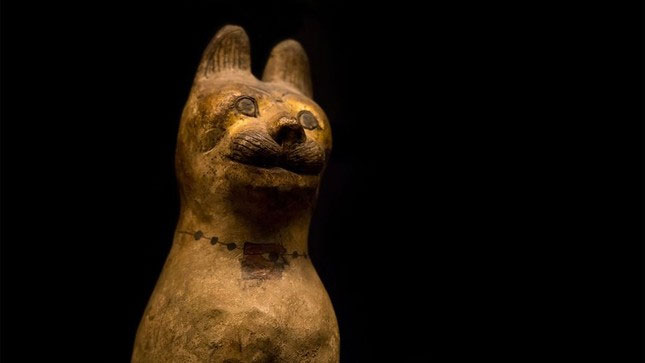 An ancient cat mummy in a wooden cat coffin. (Photo: N. Rotteveel).
An ancient cat mummy in a wooden cat coffin. (Photo: N. Rotteveel).
Animal mummies are sometimes buried with the dead. These may be beloved pets buried with their owners in the afterlife.
Sometimes, animal remains – such as cows, ducks and geese – were “prepared for cooking” and then that was embalmed.”
She also noted that these remains will be for the tomb owner and possibly their pets to eat in the afterlife.
Mummy mask
 First century AD plaster mummy mask from Minya, Egypt. (Photo: Global History Archive).
First century AD plaster mummy mask from Minya, Egypt. (Photo: Global History Archive).
The deceased were sometimes buried with masks. According to the Museum of Fine Arts, Boston, masks represent “the ideal image of the deceased”. They can be made from plaster, cardboard, linen, and in rare cases, precious metals. In 2018, archaeologists working at the site of Saqqara, an Egyptian cemetery, discovered a gilded silver mummy mask. It belonged to a priest who served Mut, the goddess of the sky.
Model boat
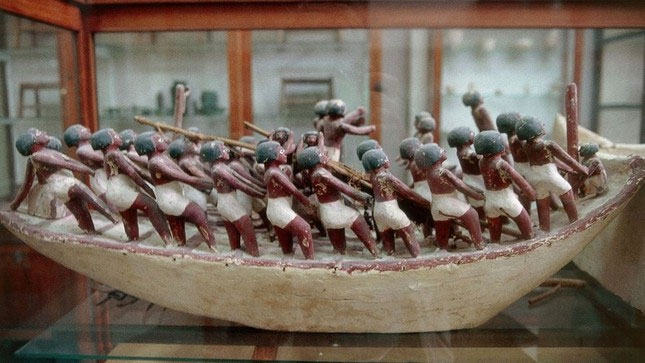 Model of a boat from a tomb in Deir el-Bahari, Egypt, dated to the 11th Dynasty, around 2030 to 1981 BC. (Photo: DeAgostini).
Model of a boat from a tomb in Deir el-Bahari, Egypt, dated to the 11th Dynasty, around 2030 to 1981 BC. (Photo: DeAgostini).
Archaeologists have also found wooden boat models in ancient Egyptian tombs. One notable example is from the tomb of Djehutynakht, a governor who lived about 4,000 years ago and was buried with 55 model boats in his tomb at the site of Deir el-Bersha, according to the Museum of Fine Arts , Boston.
These included boats for transporting troops or goods and boats for hunting and fishing. One of the boats was said to be transporting what appeared to be Djehutynakht’s mummy.





